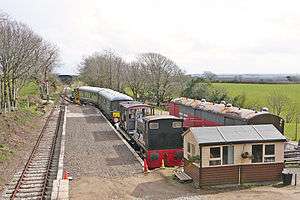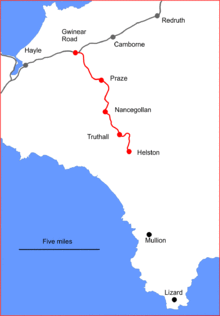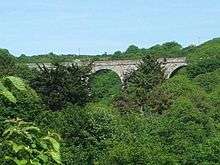Helston Railway
Coordinates: 50°07′30″N 5°18′04″W / 50.125°N 5.301°W
| The Helston Railway | |
|---|---|
 | |
 | |
| View of the now disused station at Trevarno in April 2010 | |
| Terminus | Helston railway station |
| Commercial operations | |
| Original gauge | 4 ft 8 1⁄2 in (1,435 mm) |
| Preserved operations | |
| Length | 1 mi (1.6 km) |
| Preserved gauge | 4 ft 8 1⁄2 in (1,435 mm) |
| Commercial history | |
| Closed to passengers | 1962 |
| Closed | 1964 |
| Preservation history | |
| 2010 | HR granted Light Railway Order |
| 2011 | HR re-opens |
| 2012 | HR relocates (upwards) into 'a nearby' Prospidnick |
| Headquarters | Prospidnick |
| Website | |
| http://www.helstonrailway.co.uk/ | |
| The Helston Railway | |||||||||||||||||||||||||||||||||||||||||||||||||||||||||||||||||||||||||
|---|---|---|---|---|---|---|---|---|---|---|---|---|---|---|---|---|---|---|---|---|---|---|---|---|---|---|---|---|---|---|---|---|---|---|---|---|---|---|---|---|---|---|---|---|---|---|---|---|---|---|---|---|---|---|---|---|---|---|---|---|---|---|---|---|---|---|---|---|---|---|---|---|---|
Legend
| |||||||||||||||||||||||||||||||||||||||||||||||||||||||||||||||||||||||||
The Helston Railway is a heritage railway in Cornwall which aims to rebuild and preserve as much as possible of the former 8¾ GWR Helston Railway between Nancegollen and Water-Ma-Trout on the outskirts of Helston. It is operated by the Helston Railway Preservation Company using members of the Helston Railway Preservation Society.
The Railway was a 4 ft 8 1⁄2 in (1,435 mm) (standard gauge) railway branch line in Cornwall and is the southernmost branch line in the United Kingdom, United Kingdom, opened in 1887 and absorbed by the Great Western Railway in 1898, continuing in existence as the Helston branch, it closed to passengers in 1962 and to goods in 1964.[1]
It was built to open up the agricultural district of south-west Cornwall, joining Helston to the main line railway network at Gwinear Road, between Penzance and Truro. It was 8.5 miles (13.7 km) long.
Its predominant business was agricultural, but in summer it carried holidaymakers, and its terminus at Helston was the railhead for a pioneering road connection service to the Lizard. During the Second World War there was considerable goods traffic at Nancegollan, sponsored by the Admiralty.
Original Railway

The line ran from Helston, in south-west Cornwall, to a junction with the main line of the Great Western Railway at Gwinear Road(50°11′50″N 5°20′51″W / 50.1972°N 5.3475°W)(50°06′25″N 5°16′17″W / 50.1070°N 5.2713°W). The connection there faced Penzance.
The line was 8 miles 67 chains in length. As a purely local line running through difficult terrain, it was heavily curved and graded. Although Helston is an important town, most of the intermediate area was dedicated to agriculture, with little population, and the terminus at Helston was some distance from the seaside.
The main line at Gwinear Road gave direct access to London and the rest of England, on the route that is now known as the Cornish Main Line.
History
Before the advent of the railway, Helston was an important centre for tin and copper mining, as well as being the hub of an area of considerable agricultural production. Local businessmen observed the success that followed the opening of early railways elsewhere in Cornwall and further afield, and from 1825 a succession of schemes for tramroads and railways were put forward, many of them oriented towards Falmouth or Penryn and the River Fal estuary because of the harbour facilities there, (and, later, the arrival of the Cornwall Railway, enabling onward transport of minerals by coastal shipping).
All of these schemes fell by the wayside due to the high cost of crossing the difficult terrain; after the collapse following the Railway Mania in the mid-1840s, money became increasingly scarce, and moreover the shallower seams in the mines began to become worked out, reducing the profitability of local mines.
Finally in 1879 the Helston Railway Company was formed, with a share capital of £70,000, with the object of building a standard gauge railway to Helston, not from the Falmouth area but from Gwinear Road on the West Cornwall line. The Great Western Railway was friendly towards this line, and they agreed to work the line when built.
The line received its Act of Parliament on 9 July 1880, and the first sod was cut at a ceremony on 22 March 1882. Work proceeded but the original contractor found himself in difficulties early in 1884 and work stopped for a period, but was resumed under Lang & Son of Liskeard.
Even as late as 1886[2] there was debate over the site of the Helston station; the site actually adopted, in Godolphin Road, was some distance to the east of the town centre. Some interests had proposed instead a location nearer the town; however the incremental cost would have been considerable and the proposal was finally dropped. The station was built as potentially a through station, with the idea of extension to the Lizard. This was revived from time to time, but was never acted upon.
The line was opened for the first service train on 9 May 1887.[2][3][4]
The Line in action

When the line was opened there were two intermediate stations at Praze (serving the villages of Praze-an-Beeble and Crowan) and Nancegollan. In 1906, a halt was opened at Truthall Platform, less than 2 miles north of Helston and close to the hamlet of Trannack.[5] There was also a ticket collecting platform just short of Helston until the end of 1902.[3]
The only significant structure on the line was the Cober Viaduct, more properly known as the Lowertown Viaduct, 373 feet long and with six arches.[3]
Praze
Praze had only a single platform, 223 feet long, on the up side of the line; there was a goods line formed as a loop, controlled by ground frame, on the down side.[2]
Nancegollan
Nancegollan station served an important agricultural district and also was the railhead for the fishing port of Porthleven. Originally it had a single passenger platform on the up side and a goods loop without a platform; the connections were operated by ground frame. In 1937 the facilities were considerably extended, with a full crossing facility for passenger trains and longer platforms on both lines, as well as a loop line behind the up platform and a large goods yard.[2]
In 1941 the station's goods sidings were further modified and extended in connection with airfield construction in the locality, and a new signal box with a lever frame that had been relocated from the Cornish Main Line at St Germans. A second, metal, bridge was also built at this time to carry the road over the new goods yard access lines.
Truthall
A latecomer to the passenger facilities on the branch, Truthall Halt was opened on 3 July 1905, at a location about a mile and a half north of Helston; it served the village of Trannack and also Truthall Manor. It was renamed Truthall Platform in July 1906 and reverted to Truthall Halt in the 1960s. Some tickets referred to it as Truthall Bridge Halt. It had a single platform 84 feet long on the down side of the line, though it was shortened later to about 50 feet.[2]
Helston
Laid out as a through station for the possible extension to the Lizard, Helston station had a single platform on the up side of the line; there was an engine release line, with goods facilities on the east side of the station. There was also a carriage shed for the two-coach branch train, and a single-road engine shed built in 1887, lasting until 1963.[2]
Helston station was much used by service personnel based at RNAS Culdrose from 1947.[2] The Royal Navy Air station is on the southern margin of Helston.
Absorption by the Great Western Railway

The line had been worked by the Great Western Railway from the outset, and on 1 July 1898 the line was vested in the GWR, the original Helston company being dissolved.[3]
The Great Western Railway operated a pioneering road passenger connection to Mullion and the Lizard from 17 August 1903, and a Porthleven connection was added in 1909, and surrounding villages were also served. There was also an extensive van service for goods traffic to and from the railway, developed into a motor lorry service from about 1925.[3]
A fragment of the GWR route map from about 1930 is given above, and shows several "road motor routes" radiating from Helston: there was a route to Porthleven and Breage; to Penhale (a small settlement east of Mullion, not the larger place near Indian Queens), Lizard and Lizard Point, and to Mullion; and Coverack and St Keverne, and to Manaccan; and to Falmouth and to Redruth.
The GWR formed a joint venture with the National Omnibus & Transport Company, forming the Western National Omnibus Company Ltd in 1929, and the GWR services were transferred to Western National. The GWR retained its shares in Western National until nationalisation of the railways in 1948.
Operation

The branch was "uncoloured"—the lightest engine weight classification—but this was relaxed to permit 45XX 2-6-2T locomotives to operate, and in fact these were the general motive power. 43XX 2-6-0s and 51XX 2-6-2Ts were allowed as far as Nancegollan only.[6] In the line's final years, Class 22 diesel locomotives were used to haul passenger and goods trains.
The line was single throughout, and several of the trains crossed at Nancegollan; from the opening of the passing loop there, the line was operated as two block sections, with signal boxes at Helston, Nancegollan and Gwinear Road East.
The line was sharply curved and steeply graded, with ruling gradients of 1 in 60 and 1 in 54.
In 1922 there were eight trains in each direction on the line; by 1939 this had been improved to ten (Monday to Friday) and eleven on Saturdays. The first train of the day started from Helston, as there was a small engine shed there.[7] The journey time was typically 25 minutes, and the general speed limit was 30 miles per hour (48 km/h)
Goods traffic on the branch was heavy, accounting for about two-thirds of the branch's revenue.[1] The primary traffic was agricultural, whist during the war years, and particularly during the D-Day preparations, Nancegollan saw extensive military traffic.
Local trains rarely ventured off the branch. In 1958 there were nine down and eight up trains Monday to Fridays; the last up train was formed of two sets of rolling stock, and two trains each way were mixed (passenger and goods). The 1.15 p.m. Helston to Gwinear Road had to be given special attention as it had a three-minute connection at Gwinear Road with the up Royal Duchy express for London. (The "up" direction was towards Gwinear Road.[2])
On Saturdays in that year there were fourteen down and eleven up trains, with three up trains running with double the stock. All of this was accomplished with two B-set two coach sets.
Closure
The branch was listed for closure in the Beeching Plan. On 3 November 1962 the line was closed to passengers; it was the first in Cornwall. Goods traffic continued for a further two years, finally ceasing on 4 October 1964; the track was lifted by mid-1965.
Preservation
The original concept to re-open the branch was back in 1994 when Mart Hew from Helston and officials from British Rail, surveyed the line with the idea of a feasibility study. It was decided that due to the amount of work needed and the possible revenue that could be generated, it was not worth the effort and the project was dropped. In 2002 the Helston Railway Preservation Society was formed with about 12 members and on 28 April 2005, 40 years after the line was dismantled, work began clearing the overgrown vegetation.
The line was reopened for passengers in December 2011 for the Trevarno Gardens Winter Wonderland. As of September 2012 just under 1 mile (1.6 km) of track had been relaid and is being used for public passenger rides from Prospidnick via Trevarno almost to Truthall Halt.[8]
The line is being rebuilt by volunteers and is funded by proceeds from passenger rides, donations and membership subscriptions, and by members who buy shares in the Helston Railway Company Ltd. Funds are also generated by the railway shop and a buffet. The Preservation Society gained Charity status in March 2012.
Rolling stock
The line has five rail vehicles on site: a two-car Park Royal (BR Class 103) DMU, two Ruston & Hornsby 165DS 0-4-0 diesel shunters and a BR 20 ton standard brake van. All of these vehicles are owned by members of the Helston Railway Diesel Group (HRDG) and the Helston Railway is actively restoring some of these vehicles.
Park Royal Class 103
HRDG's first purchase was a British Rail Class 103 DMU, one of only two left in preservation and the only one in a near-working condition. It has been protected by painting, but is not currently under restoration. When purchased from the West Somerset Railway, it was little more than a shell. It is currently in British Rail (BR) green livery. The individual cars are Driving Motor Brake Second (DMBS) 50143 and Driving Motor Lavatory Composite (DTCL) 56169. On 12 October 2008, one of the engines was started for the first time.
Ruston locomotive 327974
One of two Ruston shunter locomotives owned by the HRDG is number 327974. It has been restored, and has had a livery repaint into BR Blue. The locomotive is not currently in use, as a new selector fork is required. The new fork has been cast, and in February 2013 was awaiting machining. It was hoped that the repairs would be complete in time for the 2013 season.
Ruston locomotive 395305
The second of the Ruston 165DS 0-4-0 locomotives is build number 395305. It is in use as at February 2013, however it is due to be replaced by the other shunter, as soon as it becomes available, so that a new radiator can be installed. It is currently painted in BR Black livery.
BR 20-ton standard brake van
HRDG's newest purchase is a BR 20-Ton Standard Brake van, B954673. It had been in a very poor state and has undergone major restoration works which were completed in November 2011; it is in brown. The van was put into use as soon as it was completed and is now carrying passengers on the line.
Steam working
On 25–26 July 2010, steam returned to Helston for the first time since 1962, during celebration of the completion of the latest station platform on the line and the newest since Truthall Platform in 1905.
The engine Judy,[9] one of two similar preserved Bagnall 0-4-0STs, lent a working presence, courtesy of Bodmin and Wenford Railway.
The Mayor of Helston officiated at the grand opening of Trevarno Station, on 26 July 2010, with Judy in attendance. Although Judy was in steam and operating on the railway, she was unable to carry passengers, as the company were not authorised to operate passenger trains at the time.
Passenger rides
The Helston Railway is accessed by the public at Trevarno Farm near Prospidnick where there is a new car park which opened in late 2012. The trip in the brake van, using one of the Rushton shunters, runs almost to Truthall which is just under 1 mile along the completed track, and then returns to Prospidnick.
Along the line
- Nancegollen – New site proposed, as old (original site) is now redeveloped.
- Trevarno Farm – New operational base and public car park
- It is proposed that a new station will be constructed at Trevarno Farm which will be opened in 2015
- Prospidnick Halt – This is only a temporary platform and is current terminus of the Helston Railway, Though this halt may close when the proposed Trevarno Farm, (whom located just a little north of the halt), opens in 2015.
- Trevarno station – Now disused – This is one third of the way along the line and was until 21 October 2012 the main operational base of the Railway, and where passengers started their journeys.
- Truthall Halt
- Platform cleared and under both reconstruction and restoration to its former glory (and GWR style appearance, respectively).
- Helston (Water-Ma-Trout)
- It is intended that the preserved line will eventually be restored "via across the 4 arch Cober Viaduct" and right onto the outskirts of Helston (where a new and "temporary-replacement" station maybe proposed as the former Helston site itself now sadly lies within private land and redevelopment), however this may take some many years.
Current status of the Helston Rly
As of February 2015:
- The re-laid permanent way is now 1½ mile long, of which all but 175 yards is usable, with the rest awaiting the completion of the restoration of Truthall Halt and track-relaying.
- Discussions are taking place regarding the possibility of obtaining a steam locomotive from private owners.
- Plans to rebuild and restore Truthall Halt are well advanced with planning permission granted, parts of the original platform have since been cleared and uncovered. Restoration of the halt is likely to be completed by "mid-spring" 2015.
- The Trevarno Estate was sold on 22 October 2012, having been purchased by a buyer who is going to use the estate as a private house. The Railway now operates from a new temporary platform 540 yards up the line at Prospidnick. The railway has also constructed a new public car park 200 metres from the platform.
- The platform at Trevarno is now disused but the sidings (now known as Tregadjack sidings) remain and will be used for storage of stock and some maintenance operations.
- It is hoped that restoration will continue south within a few years to Water-Ma-Trout just near Helston; this would also include restoring the old Cober Viaduct.
See also
References
- 1 2 History of the Great Western Railway, vol II, MacDermot, E T, published by the Great Western Railway, London, 1932
- 1 2 3 4 5 6 7 8 Cornwall Railway Stations, Mike Oakley, 2009, Dovecote Press, Wimborne Minster, ISBN 978-1-904-34968-6
- 1 2 3 4 5 The Hayle, West Cornwall and Helston Railways, Anthony G H, The Oakwood Press, Lingfield, 1968
- ↑ Robert Smith. "The Helston Branch". Retrieved 2009-02-21.
- ↑ The Railways of Great Britain, a Historical Atlas, Cobb, Col M H, Ian Allan Publishing Ltd, Shepperton, 2003
- ↑ Operation Cornwall, W S Becket, Xpress Publishing, Caernarvon, undated, ISBN 1-901056-25-2
- ↑ The Heyday of GWR Train Services, Semmens, P W B, David & Charles, Newton Abbot, 1990
- ↑ "Track Map & Progress". Website of Helston Railway Preservation Company Ltd. Retrieved 2 September 2012.
- ↑ ""Judy" Bagnall 0-4-0 ST Built 1936". Cornish Steam Locomotive Preservation Society. Retrieved 14 July 2010.
External links
| Wikimedia Commons has media related to Helston Railway. |